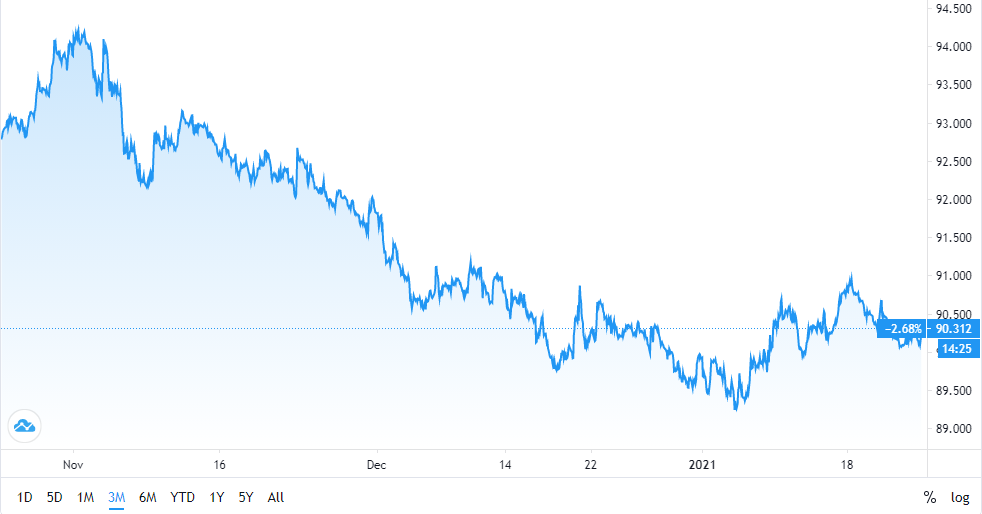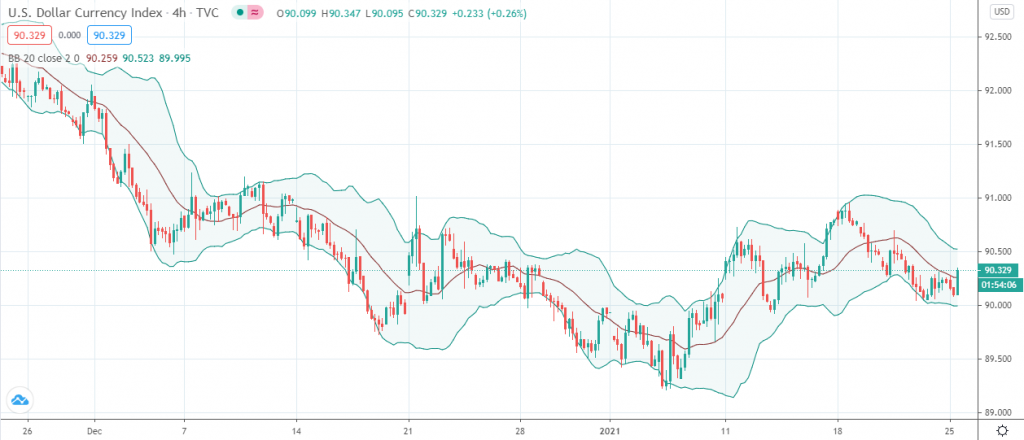- Production problems are the latest hurdle to a seamless rollout of Covid-19 vaccination programs across Europe. AstraZeneca says it will not be able to honor about 60% of the EU’s vaccine requirements in the first three months of 2021. This latest shock is as demoralizing to the market as the increased incidence of new and more lethal coronavirus strains.
- The eurozone started the year with strict lockdowns across most of its 27 member states, and the shock on economic activity is enormous. Already, the ECB is expecting a double-dip recession, which might worsen if vaccine supply chain problems increase.
- The recession fears are fueling an uptick in demand for safe-haven currencies. At the time of writing, the euro, the pound sterling, and the US dollar index were down 0.17%, 0.07%, and 0.04% respectively. The Japanese yen, contrariwise, was up 0.03%.
The US dollar could weaken further
Joe Biden is cruising towards his first week as the US President, and he has already signed a spate of executive orders. More than half of the executive orders touch on coronavirus, and a large percentage of the remaining are on economic recovery. For instance, more support for struggling Americans is on the way, which could be to the tune of $2,000 per person.
The flip side of the massive stimulus package is that the US dollar might continue to remain weak – it is down 0.54% in the last five days. But a shrinkage in the EU’s and the UK’s business activity this month seems enough to persuade USD bears to hold their horses. Because of the soft European data released on Friday last week, the US dollar opened trading on Monday 0.05% up.

Soft European data is undermining the euro
IHS Markit anticipates the euro zone purchasing managers’ index (PMI) to disappoint in January. An early reading of the PMI tells IHS Markit that the index could decline to 47.5, down 1.6 points. If so, January will be the third straight month that the eurozone’s PMI comes in below 50 points, signaling the deepening of an already fearsome economic crisis.
No wonder the market is punishing the euro more harshly than all the other risky currencies. This week could be even more challenging for the Euro as market volatility is likely to shoot up on the back of the FOMC statement on Wednesday and US advance GDP data on Thursday.
Volatility is high across the market
Even with expectations for higher volatility firming, the current situation is not any better. Across the broader forex market, price swings are high – they have been this way for much of 2020. However, the EUR seems to lead the way in terms of the magnitude of price fluctuations.
In figures 2 and 3 below, notice that the bands tracking the US dollar index’s price fluctuation are narrowing, while the Euro FX index’s Bollinger Bands seem to be widening. The market may be pricing in events of this week where the possible consensus could be that the euro might continue to decline against major rivals.


Conclusion
Coronavirus could remain the biggest influence on forex market activity if the current vaccine situation persists. The world is working overtime to roll out vaccination programs, but supply chain bottlenecks and production problems are undermining efficiency – not to mention the increased incidence of new strains of Covid-19.
The week ahead could be eventful, especially in terms of volatility. Early indications show the market anticipating a weaker USD going forward, and the Euro’s volatility might strengthen.




